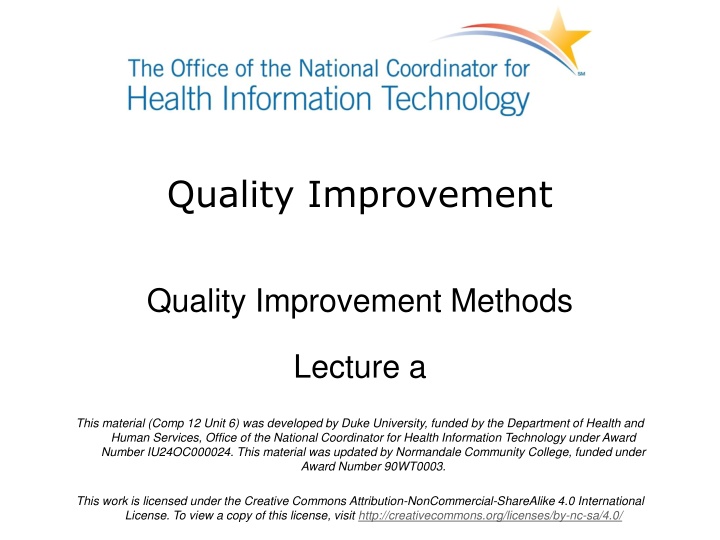
Quality Improvement Methods in Healthcare
Explore strategies and examples of quality improvement projects in the healthcare setting, emphasizing the role of leadership in enhancing patient care and service delivery.
Download Presentation

Please find below an Image/Link to download the presentation.
The content on the website is provided AS IS for your information and personal use only. It may not be sold, licensed, or shared on other websites without obtaining consent from the author. If you encounter any issues during the download, it is possible that the publisher has removed the file from their server.
You are allowed to download the files provided on this website for personal or commercial use, subject to the condition that they are used lawfully. All files are the property of their respective owners.
The content on the website is provided AS IS for your information and personal use only. It may not be sold, licensed, or shared on other websites without obtaining consent from the author.
E N D
Presentation Transcript
Quality Improvement Quality Improvement Methods Lecture a This material (Comp 12 Unit 6) was developed by Duke University, funded by the Department of Health and Human Services, Office of the National Coordinator for Health Information Technology under Award Number IU24OC000024. This material was updated by Normandale Community College, funded under Award Number 90WT0003. This work is licensed under the Creative Commons Attribution-NonCommercial-ShareAlike 4.0 International License. To view a copy of this license, visit http://creativecommons.org/licenses/by-nc-sa/4.0/
Quality Improvement Methods Learning Objectives Describe strategies for Quality Improvement Describe the role of Leadership in Quality Improvement 2
Quality Improvement in the Health Care Setting Quality Improvement an approach to improvement of service systems and processes through the routine use of health and program data to meet patient and program needs (Chang, 1999) Examples of Quality Improvement Projects Redesigning a Clinical Office Reducing the time for patient intake Redesigning the information flow in a laboratory Increasing the access to care 3
Putting Quality Into Practice The "Putting Quality Into Practice" video series demonstrates the effects of workflow, resource and systems reviews, electronic medical records (EMRs) implementation and other quality improvement efforts on a practice. This series is an eight-part series that plays in a loop. There is approximately 60 minutes of video. The series was produced by the ABIM Foundation, a non-profit foundation. http://www.abimfoundation.org/Resource-Center/Video/PQIP.aspx 4
Duke Databank for Cardiovascular Disease Hardware configuration for the Miocardial Research Unit from the early 1970's at Duke University Medical Center. reprinted from https://www.dchi.duke.edu/ Photograph from the early 1970's of Dr. Eugene Stead and a young clinician. The photograph shows the two gentlemen talking in the Maicardial Research Unit at Duke University Medical Center. Dr. Stead was an early promoter and practitioner of evidence based medicine. reprinted from https://www.dchi.duke.edu/ Images reprinted fromhttp://digitaldukemed.mc.duke.edu/databank/Images/ 5
Three Major Concepts 1. Quality is a Measurable Phenomenon Six dimensions : Safe, effective, timely, patient-centered, efficient, equitable Safety Errors are definable and measurable The right plan is defined on the basis of professional standards To avoid errors, you must decide on the best plan in the context of professional standards, and the plan must be executed Accountability Measurable performance with consequences Currently lies primarily with physicians Physicians will increasingly be held accountable for performance at the microsystem level 2. 3. 6
Quality Improvement Knowing is not enough; we must apply. Willing is not enough; we must do. - Goethe 7
Focus You have been introduced to concepts and practices that will enable you to: Identify and document the processes in a health care setting, Collect and analyze information about processes in the health care setting, and Redesign the workflow processes and streamline this redesign Quality Improvement methods and tools enable you to: Collect and compile information on an ongoing basis, Analyze the information for root causes, Make decisions on how to eliminate these problems (process improvement), Change processes based on this analysis, and Redesign (strategic change), and set timetable for these steps. 8
Quality Improvement in Health Care Settings In 2004 Stephen Shortell likened the U.S. health care system to a shoddily constructed building located in the pathway of an impending natural disaster Quality can be improved in the Health Care Setting by understanding the Foundations and Methods Quality Improvement. 9
Foundations of Quality Improvement Walter Shewhart W. Edwards Deming Joseph M. Juran 10
PDSA Cycle 11
Quality Improvement Methods Summary Lecture a Strategies for quality improvement (QI) Need for aggressive QI in health care Role of leadership in creating a culture that supports QI 12
Quality Improvement Methods References Lecture a References Califf, R. M. (2006). Translating Clinical Trials into Practice (keynote). Tex Heart Inst J., 33(2), 192-196. Chang, R. Y. (1999). Continuous Process Improvement (Rev ed.). San Francisco, CA: Jossey-Bass Pfeiffer. Kohn, L. T., Corrigan, J. M., & Donaldson, M. S. (Eds.). (2000). Institute Of Medicine: To Err is Human: Building a Safer Health System. Washington, DC: National Academy Press. Ransom, S. B., Joshi, M. S., & Nash, D. (Eds.). (2004). The Healthcare Quality Book: Vision, Strategy, and Tools (1 ed.). Chicago, IL: Health Administration Press. Tague, N.R, (2004) The Quality Toolbox, Second Edition, ASQ Quality Press, 390-392. Images Slide 5: Dr. Eugene A Stead, Jr. [photo]. Retrieved from: http://digitaldukemed.mc.duke.edu/databank/Images/stead_eugene_thumbnail.jpg Slide 5: Hardware Configuration [image]. Retrieved from: http://digitaldukemed.mc.duke.edu/databank/Images/hardware_configuration_1971.jpg 13
Quality Improvement Methods Lecture a This material was developed by Duke University, funded by the Department of Health and Human Services, Office of the National Coordinator for Health Information Technology under Award Number IU24OC000024. This material was updated by Normandale Community College, funded under Award Number 90WT0003. 14






















